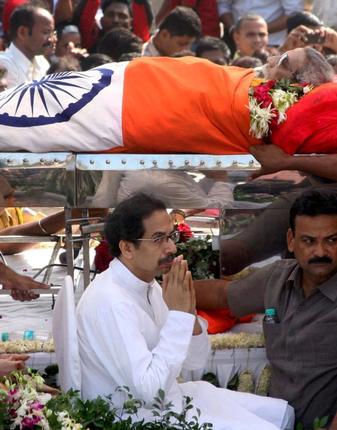
Mumbai, November 18: The mortal remains of Bal Thackeray, a Hindutva mascot and flagbearer of Marathi pride, were consigned to flames as lakhs of mourners joined the Shiv Sena founder’s grieving family to bid him a tearful farewell, with the city observing a virtual shutdown.
In a spontaneous outpouring of grief, a sea of humanity, unprecedented in recent memory, descended on the streets leading from “Matoshree”, Thackeray’s Bandra home, to Shivaji Park, to catch the last glimpse of the uncrowned king of Mumbai.
As several times in life, the Thackeray phenomenon was in evidence once again in death as he brought Mumbai to a halt with all marketplace, from the swanky malls to the tiny tea stalls and ‘paan—beedi’ kiosks, closed and all roads leading to “Matoshree”, Shiv Sena Bhavan in Dadar and Shivaji Park, where his last rites were performed.
Loud roars of “Parat ya parat ya Balasaheb parat ya (Come back, come back, Balasaheb come back), Kon ala re, kon ala Shiv Senecha wagh ala (Who has come, who has come, Shiv Sena’s tiger has come)” and “Balasaheb amar rahe” (long live Balasaheb) rent the air as an emotional Uddhav, the youngest son of the departed leader and Sena’s executive president, lit the pyre.
In a reflection of the respect Thackeray commanded across the board, a galaxy of politicians, from allies to rivals, film stars to captains of industry were attendance.
Lakhs of people on Sunday came out to catch a last glimpse of Balasaheb Thackeray and pay homage to him as the Shiv sena patriarch’s funeral procession started from his residence amidst a complete shutdown with markets shut and taxis and autos off the roads.
The body of 86-year-old Sena leader, who breathed his last on Saturday, was taken out of his residence ‘Matoshree’ in subruban Bandra this morning in a hearse adorned with flowers.
People in huge numbers thronged roadsides, flyovers and balconies of their buildings to catch a glimpse of the Sena leader who roused emotions on Marathi pride and catapulted the party to power in Maharashtra in the 1990s.
A bandh-like situation prevailed in many parts of the city, Navi Mumbai and Thane in the wake of Balasaheb’s death.
Markets were shut and taxis and autos off the streets. The authorities have advised Mumbaikars to take to the roads only in the case of an emergency.
Extensive security arrangements have been put in place in the state, particularly in Mumbai, with over 20,000 police personnel deployed in the metropolis to keep a tight vigil.
Security has been beefed up at ‘Matoshree’ and Shivaji Park with vehicular traffic prohibited in and around the area.
Shiv Sainiks have also formed a human chain to enable the procession to pass smoothly.
The bereaved Thackeray family is accompanied by several Sena leaders including Manohar Joshi, Diwakar Raote, party spokesperson Sanjay Raut, Neelam Gorhe, Vinayak Raut, Anil Desai, Subhash Desai, senior BJP Gopinath Munde, among others.
Related: Bal Thackeray: Leader who brought ethnic politics to Mumbai melting pot







Comments
Add new comment